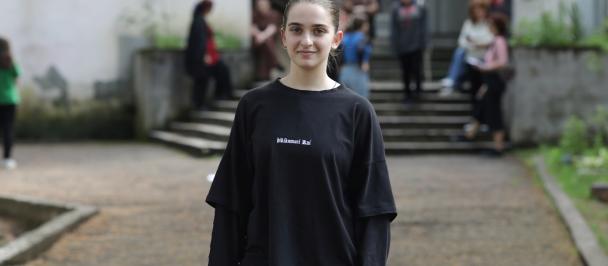EU and UNDP Help Revive Georgia's Mosaic Heritage
Piece by Piece
July 19, 2024

Some say that a mosaic is music made of countless ceramic pieces. In the 20th century, Georgia had a rich tradition of these ceramic songs, with mosaic murals adorning public spaces, especially in the western parts of the country. As the old Soviet infrastructure deteriorated with time, so did the unique mosaics recognized for their artistic, cultural, and historical value.
"Georgian mosaics from the 20th century are notable for their detachment from Soviet ideology. Instead, they focus on themes drawn from Georgian folklore and the preservation of national identity," explains Natalia De Pita, a well-known mosaic expert from the ‘Ribirabo Foundation’.
Natalia was part of an expert group that worked on restoring three unique mosaic murals in the Samegrelo region: 'Lady in Red,' 'Summer in Samegrelo,' and 'Musicians.' This effort, carried out by the 'Mosaica Studio' Crafts Development Centre with Georgian and French experts from the 'Ribirabo' Foundation, was supported by the EU and UNDP as part of the EU4Dialogue project.
Restoring 20th-century mosaics was more than an artistic project; it was a tribute to Georgia's rich history and cultural heritage, shared by communities divided by conflict in the 1990s. Similar murals exist on both sides of the conflict divide and their restoration is part of this common cultural legacy.

Mosaics Reborn
‘Lady in Red,’ depicting a stunning and confident woman, stands out as one of the most notable mosaic pieces restored in the Samegrelo region. Along with the other two murals, this mosaic was carefully removed from the crumbling walls of Rukhi village and transported to the restoration studio in Zugdidi.
The restoration journey was fraught with challenges. In Rukhi, the team found that the load-bearing wall behind one mural was completely ruined, requiring innovative methods to safely remove the fragments without causing further damage. Wild ivy growing between the walls complicated the process, sometimes leading to the loss of lower sections of the mosaics. To overcome these difficulties, the team developed a new technique that involved securing the angles and removing the mosaics in small portions to mitigate risks.

Youth Volunteers Lead the Way
Local youth from conflict-affected regions enthusiastically volunteered for the mosaic restoration project, playing a crucial role in its success. The restoration process, requiring meticulous attention to detail and profound respect for cultural heritage, involved training young enthusiasts in monumental mosaic techniques led by specialists from the ‘Ribirabo Foundation’, guided by Natalia De Pita.
"Removing and cleaning each part and paying attention to every little detail is very important. I truly enjoyed differentiating and separating mosaic pieces by colours," shares Lizi Shengelia, a dedicated local volunteer.
With the painstaking restoration complete, these mosaics have been carefully reinstalled in selected locations, including outdoor pavilion walls, now serving as a captivating tourist attraction in Zugdidi. Through meticulous work and community involvement, new life has been breathed into these incredible murals, the hidden treasures of Georgia’s cultural tapestry.
Empowering Communities and Building Resilience
The restoration of historic mosaics is one of many civic initiatives supported by the EU and UNDP as part of the EU4Dialogue project. By engaging civil society, municipalities, and communities, these local projects foster citizen participation, promote peace, and build resilience in communities affected by conflict. Since 2020, EU4Dialogue supported 44 local initiatives, providing conflict-affected communities with economic aid, educational opportunities, employment prospects, counselling, and other types of assistance.

Background Information
EU4Dialogue: Support to Conflict Transformation in the South Caucasus and the Republic of Moldova is a joint initiative of the EU and UNDP under the broader EU4Dialogue programme. The project partners with local civil society organizations and grassroots groups to improve socio-economic conditions for people, build livelihoods, drive progress toward gender equality, promote youth engagement and support the peaceful transformation of conflict.
Disclaimer
This story was produced with the financial support of the European Union and UNDP under the EU4Dialogue project. Its contents do not necessarily reflect the EU and UNDP views.

 Locations
Locations





